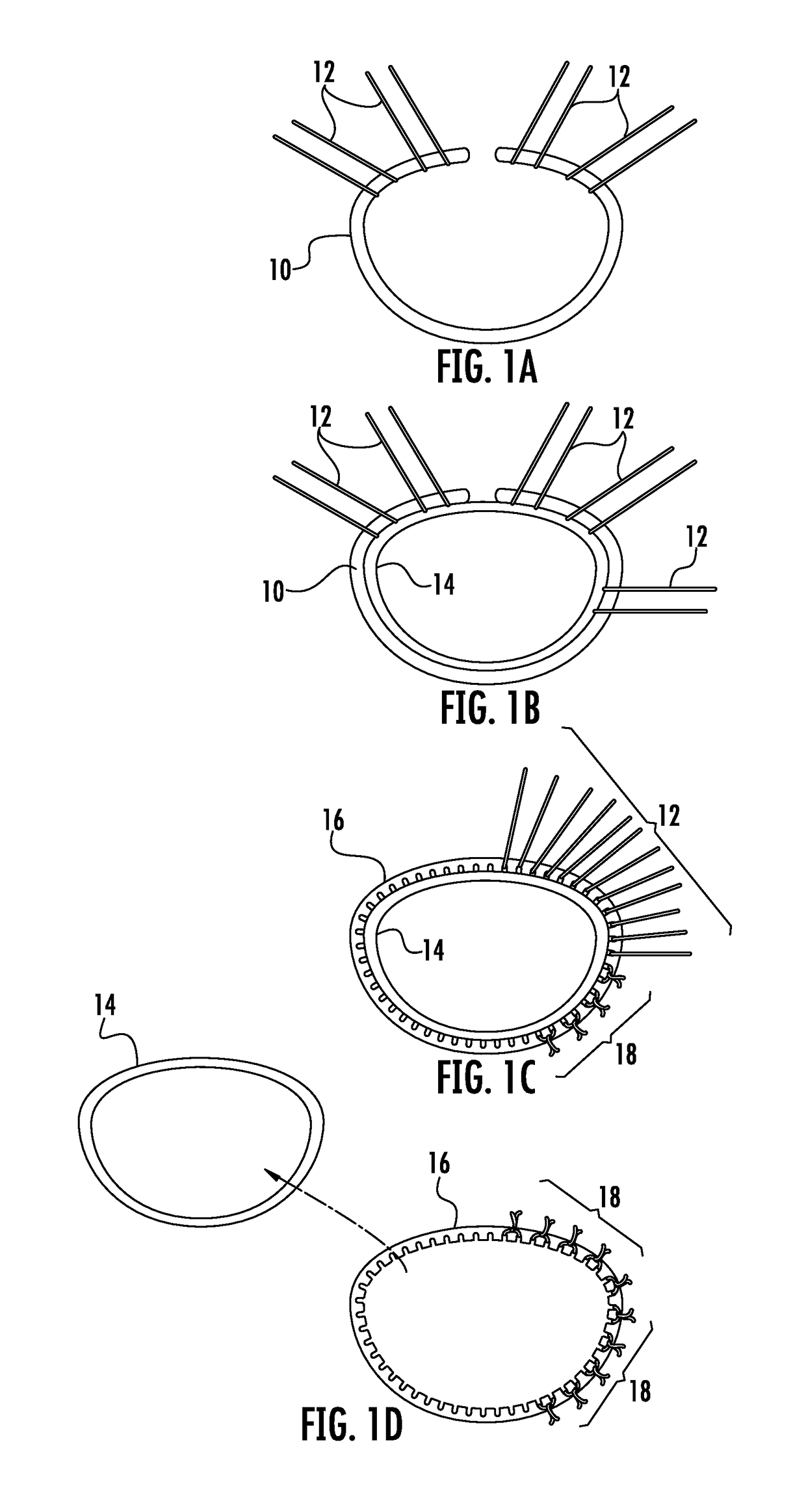Prosthetic device for heart valve reinforcement and remodeling procedures
a technology for aortic root and aortic valve, which is applied in the field of prosthetic devices, can solve the problems of increased labor, difficulty in ensuring the safety of patients, and difficulty in properly sized heart valve reinforcement rings, and achieves the effect of greater ease and accuracy
- Summary
- Abstract
- Description
- Claims
- Application Information
AI Technical Summary
Benefits of technology
Problems solved by technology
Method used
Image
Examples
embodiment 300
[0047]Referring to FIGS. 6A and 6B, in another embodiment 300 of a two-ring system, the grooves 320 may be formed on the inner ring 314 instead of the outer ring 316. The inner ring 314 may also have a complimentary profile to the outer ring 316 thereby minimizing the overall size of the two rings 314, 316 when interlocked. More specifically, the inner ring 314 includes a concave outer surface 330 that complimentarily mates with a convex inner surface 332 of the outer ring 316. The grooves 320 formed on the inner ring 314 form tooth-like projections that the sutures 12 are tied down against. Additional sutures 12 may be wrapped around both rings 314, 316, securing the entire embodiment 300 to the annulus of the heart valve. The inner ring 314 may also include hooks and tie-down structures for the sutures 12 as described in FIGS. 2A, 2B and 4, and accompanying text.
embodiment 400
[0048]Referring to FIG. 7, in another embodiment 400, the grooves 420 on the outer prosthetic ring 416 may include a gripping material 422, such as a rubber coating, formed inside the grooves 420. The gripping material 422 allows the sutures 12 to be pulled into and out of the grooves 420 without fear of damage and to enable positioning and testing of the prosthetic ring 416. Once the fit is determined to be optimal, the sutures 12 may be tied down against the outer ring 416 as described previously. As may be appreciated by one skilled in the art, gripping material 422 may also be added to grooves 420 formed on an inner ring 320, as shown in FIGS. 6A and 6B, if used.
embodiment 500
[0049]Referring to FIG. 8, in another embodiment 500, the prosthetic ring 516 may also be sheathed in a mesh material 534, enabling a surgeon to sew the prosthetic ring 516 directly to the annulus. The mesh material 534 provides an additional method of anchoring the prosthetic ring 516 to the annulus where grooves and other tie-down structures described above, prove to be inadequate to create the fit the surgeon desires. By sewing through the mesh material 534, the surgeon may further secure the prosthetic ring 516 to achieve the most optimal fit.
[0050]Referring to FIGS. 9A-9D, 10A, 10B, and 11-13, similar concepts can be applied to remodeling of the aortic root of the heart. Various applications include, but are not limited to, annular reinforcement using a ring system, using a graft system, or a composite ring / graft system. Which can also be secured in a variety of ways as previously described, but in addition, a technique can be utilized where a ring is secured to the annulus and...
PUM
 Login to View More
Login to View More Abstract
Description
Claims
Application Information
 Login to View More
Login to View More - R&D
- Intellectual Property
- Life Sciences
- Materials
- Tech Scout
- Unparalleled Data Quality
- Higher Quality Content
- 60% Fewer Hallucinations
Browse by: Latest US Patents, China's latest patents, Technical Efficacy Thesaurus, Application Domain, Technology Topic, Popular Technical Reports.
© 2025 PatSnap. All rights reserved.Legal|Privacy policy|Modern Slavery Act Transparency Statement|Sitemap|About US| Contact US: help@patsnap.com



